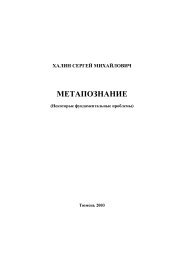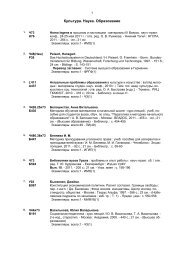The Economic History of Byzantium - Dumbarton Oaks
The Economic History of Byzantium - Dumbarton Oaks
The Economic History of Byzantium - Dumbarton Oaks
Create successful ePaper yourself
Turn your PDF publications into a flip-book with our unique Google optimized e-Paper software.
980 NICOLAS OIKONOMIDES<br />
650 and the second around 1100. <strong>The</strong> first period might be described as that <strong>of</strong> the<br />
command economy, in which the state exerted close control and functioned as a kind<br />
<strong>of</strong> pump, distributing and collecting money on the salary/tax system. <strong>The</strong> second period<br />
was closer to the free economy and was notable for its greater decentralization<br />
and for the significance in its functioning <strong>of</strong> the privileged treatment <strong>of</strong> individuals.<br />
<strong>The</strong> State Economy in the Dark Ages (7th–9th Centuries)<br />
For the first period, from the mid-seventh to the mid-ninth century, we have no archival<br />
material whatsoever and very few narrative sources. It is thus extremely difficult<br />
to monitor the course <strong>of</strong> the state economy in any detail. However, we can be sure that<br />
the principal characteristics <strong>of</strong> the fiscal organization that we know to have applied in<br />
the subsequent period must have made their appearance during the dark ages.<br />
<strong>The</strong> State and Peasants<br />
<strong>The</strong> collapse <strong>of</strong> the ancient system <strong>of</strong> cities, which coincided chronologically with the<br />
large-scale invasions <strong>of</strong> the ancient world, contributed to the intensive ruralization <strong>of</strong><br />
the empire and, <strong>of</strong> course, <strong>of</strong> its public economy, which for quite some time continued,<br />
naturally enough, to function in accordance with the traditions <strong>of</strong> late antiquity. Only<br />
a small portion <strong>of</strong> the economy was monetized, and the basic land tax continued to be<br />
the annona, which was collected in kind. In order to determine the tax owed by each<br />
individual, the state used the system <strong>of</strong> indiction (epinemesis): the central administration<br />
fixed the total sum it expected to collect in the following year, and this was then distributed<br />
among the various administrative subdivisions <strong>of</strong> the empire—large and small—<br />
so as to produce the sum in tax expected from each taxpayer and calculated on the<br />
basis <strong>of</strong> units such as the iugum and the caput. 13 <strong>The</strong> last mention <strong>of</strong> distributive taxation<br />
is in 710. 14 After that time, a trace <strong>of</strong> it lived on in the principle <strong>of</strong> tax solidarity<br />
within the communities <strong>of</strong> small farmers, under which the peasants were obliged to<br />
contribute to the payment <strong>of</strong> tax demands that other members <strong>of</strong> the community were<br />
unable to meet (because they were absent, for instance, or were in grave financial<br />
trouble). <strong>The</strong> purpose <strong>of</strong> this principle, as it had been <strong>of</strong> the system <strong>of</strong> distributive<br />
taxation, was to ensure that the state received in full all the revenue it expected to<br />
collect from the given tax unit.<br />
This system, which was unfair, onerous, and <strong>of</strong>ten uneconomical (since it was difficult<br />
to revise and consequently <strong>of</strong>ten failed to tax new commodities), was gradually<br />
replaced by another under which the tax was determined by the value <strong>of</strong> the commodi-<br />
13 For the early Byzantine tax system, see A. H. M. Jones, <strong>The</strong> Later Roman Empire (Oxford, 1964),<br />
1:119–20, 206–7, 235–37, 284, 295, 444–69; J. Karagiannopoulos, Das Finanzwesen des frühbyzantinischen<br />
Staates (Munich, 1958); W. G<strong>of</strong>fart, Caput and Colonate: Towards a <strong>History</strong> <strong>of</strong> Late Roman Taxation<br />
(Toronto, 1974); P. Lemerle, <strong>The</strong> Agrarian <strong>History</strong> <strong>of</strong> <strong>Byzantium</strong> from the Origins to the Twelfth Century<br />
(Galway, 1979), 1–26. See also J. Durliat, Les rentiers d’impôt (Vienna, 1993).<br />
14 <strong>The</strong>ophanes, Chronographia, ed. C. de Boor, 2 vols. (Leipzig, 1883–85), 1:377 (hereafter <strong>The</strong>ophanes).<br />
It was an extraordinary tax raised to fund a campaign.








